Foenix Rising
What is it? A retro computing newsletter, focused on golden-age vintage and new-retro offerings such as the Foenix line of systems.
If you are viewing this page from VCF Midwest, you are likely interested in some combination of Foenix Retro Systems, retrofitting your F256 with MIDI and a Dream IC, or MIDI software development.
Bookmark this page and keep an eye on the Foenix Marketplace for upcoming publish/push of Foenix Rising Newsletters and software similar to the MIDI Retro-scope demo shown at VCF MW 2024.
-Michael (EMwhite)
tldr; DIRECT LINK TO the nanoScript (SpeedScript) issue download (click here to download #10); This is the ‘anchor’ issue where the porting effort was first discussed; To hit the Foenix Marketplace directly, click here.
also; DIRECT LINK TO download SIDlab documentation (click here); stay tuned for programming examples and articles about SIDlab and the Commodore SID IC in general; all can be found on the Foenix Marketplace directly, click here and the 8-bit Wall of Doom channel here.
Entering our 3rd year, Foenix Rising has published 15 issues beginning with long-form (24 to 32 page) journals; over 300 detail packed pages in total.
In early 2023, the .pdf publication transitioned to a short-form ‘FLASH!’ format, yielding issues between 4-8 pages in length, primarily focused on software development with retro tie-ins to famous products, influential publications, and trailblazing personalities (e.g., Visicalc, Dr. Dobbs Journal, and Steve Wozniak).
The latest: To close 2023, we briefly returned to our long-form format, publishing a special end-of-year 25-page issue; Here is the front page:
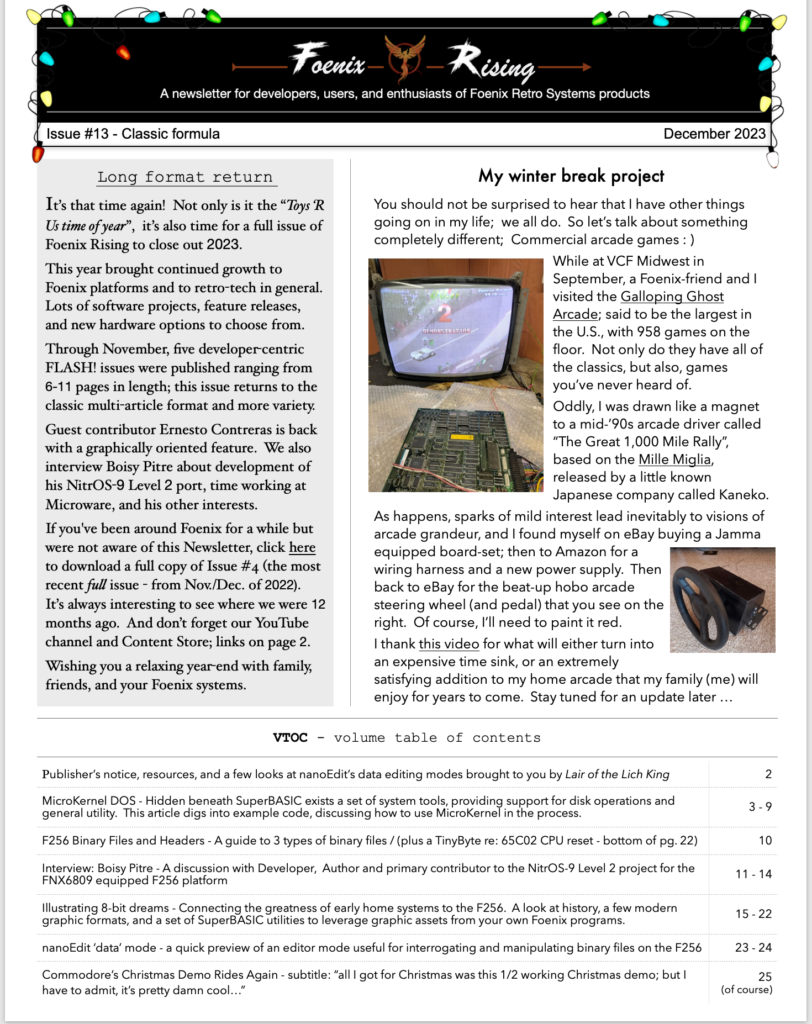
You can download this issue as a .pdf via browser download by clicking on this link here. (depending on your browser security settings, you may struggle with direct download, so be sure to pay attention to messages.)
While Foenix Rising’s layout is oriented for print (perfect for your morning coffee or weekend hammock reading), the two-column format also presents well on a cell phone or for *pad browsing. In addition to text, tables, pictures and formatted code samples, you will find linked or embedded videos and web links to related information and resources.
What else? All of our content (newsletter and the binary and supporting data on the Foenix Marketplace) is free with no strings attached, no mailing list to subscribe to (or unsubscribe from); come and go as you please.
We are open for comment. We strive for accuracy and consider our content well-researched, but open to suggestions and corrections via feedback links on our related Marketplace/Appstore and below.
We also have a YouTube channel with related vintage & new-retro content coined: “8-Bit Wall of Doom”; it is brand new, so bear with us as we build up the quality and quantity of content on the channel. Our subscriber list is modest, but we hope to grow to over 1,000 subscribers with your help.
Where? Click the links (images) below for direct download of 5 sample issues; also for a link to the Foenix Marketplace, which is the official site and where Newsletters are published. Please see the “Site FAQ” and “What’s new” on the site for more information. (Don’t forget to filter on ‘Newsletter’, if that is what you are interested in).
Thank you for dropping by.
Michael (EMwhite)

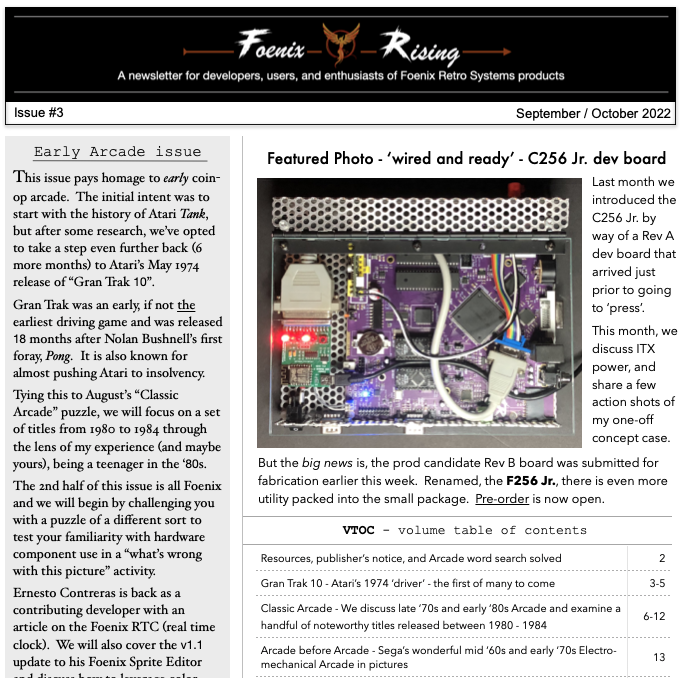
Issue #3 – Early Arcade Issue
Published October, 2022 – 32 pages
Includes several features on commercial arcade including the TTL marvel, Gran Trak 10; ‘late’ Electro-Mechanical (EM) amusements; a discussion of the original Pacman algorithm, and a look at five of our favorite commercial arcade titles (one per year).
Also, a review of the Foenix Sprite Editor by Ernesto Contreras, a tutorial in Beginner’s Corner #3 (sprite animation using BASIC816), and a preview of the [then, named] Foenix C256 Jr. development system.
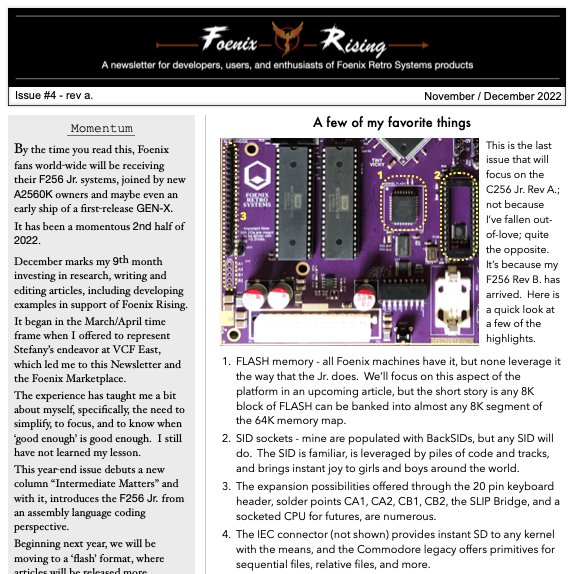
Issue #4 – “Kernals”, kernels, and the F256K
Published December, 2022 – 26 pages
Features a discussion on microcomputer kernels, a discussion with Gadget, the developer behind TinyCore MicroKernel, some vintage fun via legendary adverts, and a column entitled “Intermediate Matters” which dusted off an old COMPUTE! article and implemented an ‘on steroids’ version of a Mersenne Prime generator developed originally for a Rockwell AIM-65 machine in 1979 but ported to the C256 Jr. by yours_truly in 2022.

Issue #5 – Memory Mgmt. on the F256
Published January, 2023 – 8 pages
Discusses memory use and the 65C02 memory map, the need for a MMU and facility provided by VICKY; we also port a piece of Apple II code written by Columbia Computer Science Professor, Steven Edwards which uses bit-mapped graphics to simulate 30 bouncing ‘balls’.
The technical discussion and code base adds a sprite set and code to enable on-screen telemetry, which are animated to reflect statistics on memory paging. You’ll be impressed by the resulting performance of the paging algorithm.
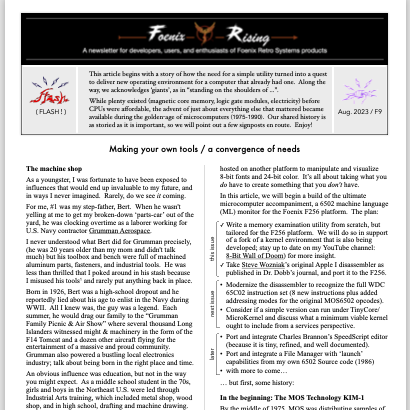
Issue #9 – Evolution of ML Monitors
Published August, 2023 – 7 pages
Starting with Wozmon, we take a stroll from the original Apple I into Apple II lore, and to Commodore.
In the early days, microcomputers included embedded 6502 monitors but as operating environments (the BASIC interpreter) ‘improved’, precious ROM footprint became tight and the monitor left the building.
The F256 platform has a well capable environment called SuperBASIC and an extensible DOS layer, but there are limited tools for developers. We intend to change this by writing our own. The saga starts here!
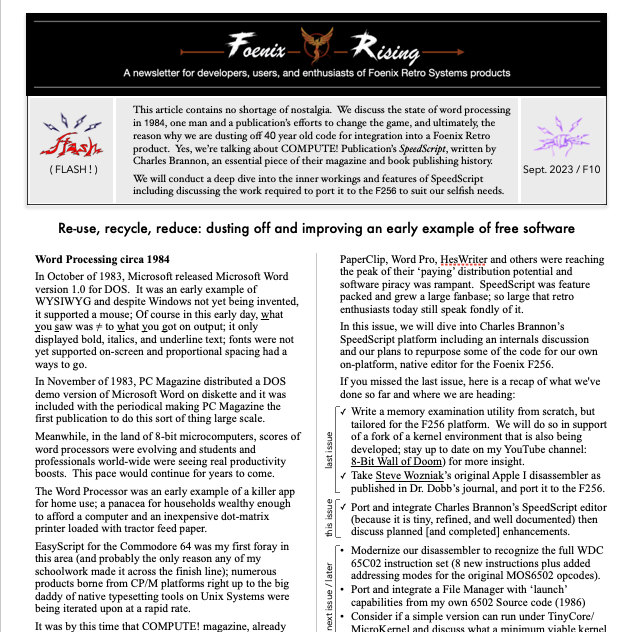
Issue #10 – SpeedScript to nanoScript
Published September, 2023 – 11 pages
This article begins with a reminder of what Word Processing looked like 40 years ago and then dives into an application released by COMPUTE! Publishing in the early 80s and built a hearty fanbase.
We quickly transition into discussion on porting it for our own purposes (an embedded editor for the Foenix F256 platform).
A deep dive into general structure, efficiency, utility, and how much we will re-use is discussed along with a draft command set for our release, nanoEdit F256.
And finally, click here for a direct link to the Foenix Marketplace. Note that this is an http site, not an https site; we are working on a native on-platform client and secure http is not feasible on 8-bit platforms just yet.
